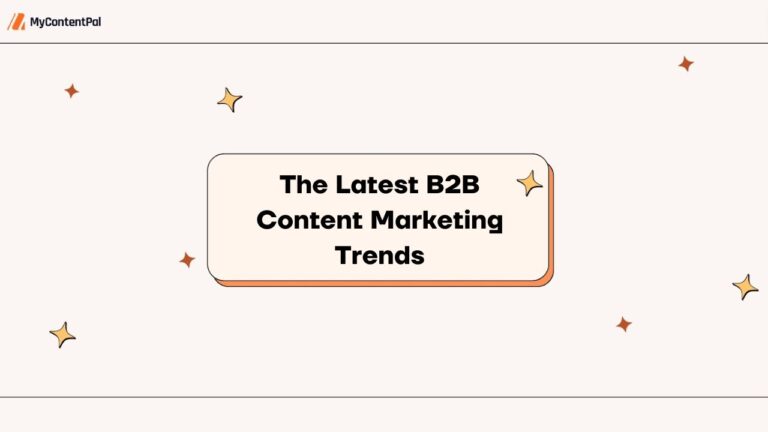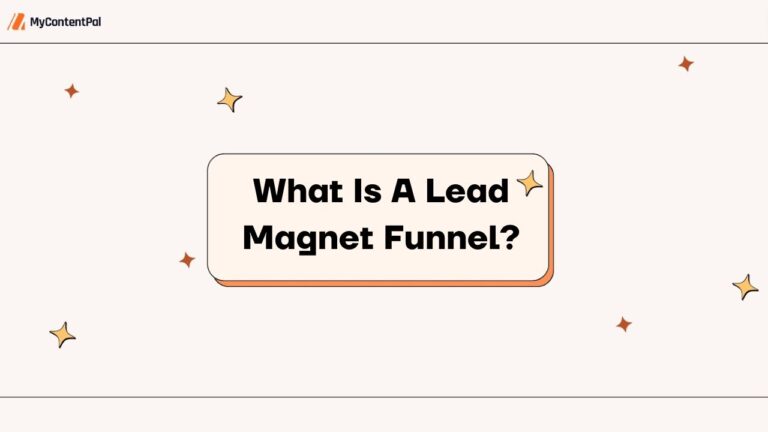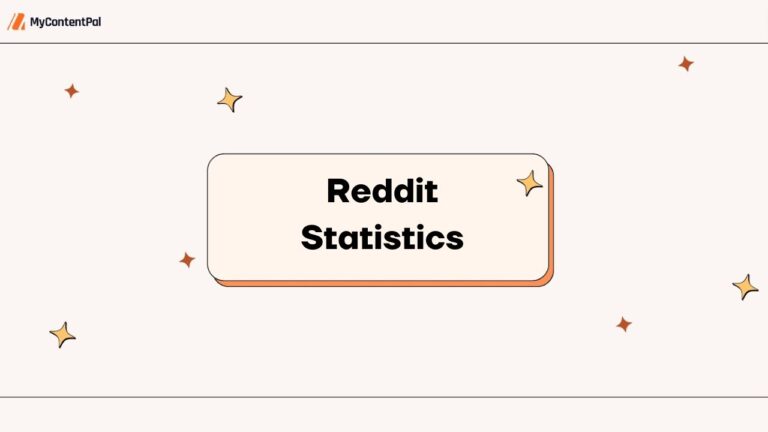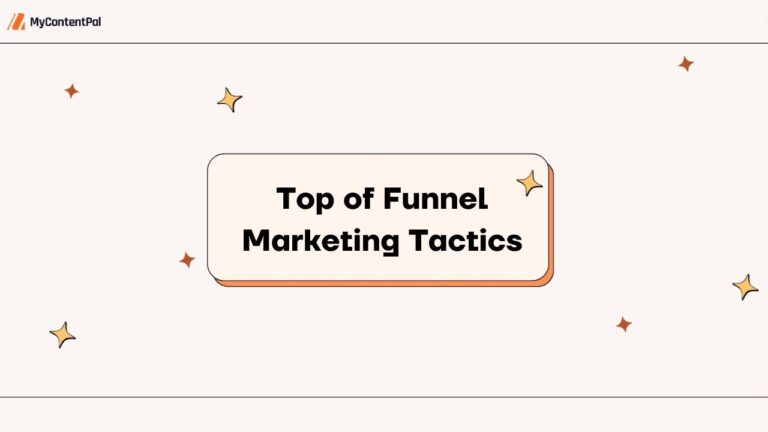B2B content marketing is essential if you want to generate more leads and increase your revenue. However, to do this, you need to have a detailed and effective strategy in place. So, I’ve created this guide to tell you everything you need to know before you implement your strategy and to show you how to execute it. I give you:
- A detailed explanation of B2B content marketing.
- A breakdown of the buying centre.
- An explainer on the buyer’s journey.
- 5 steps to help you create a successful strategy.
Let’s jump right in!
What Is B2B Content Marketing?
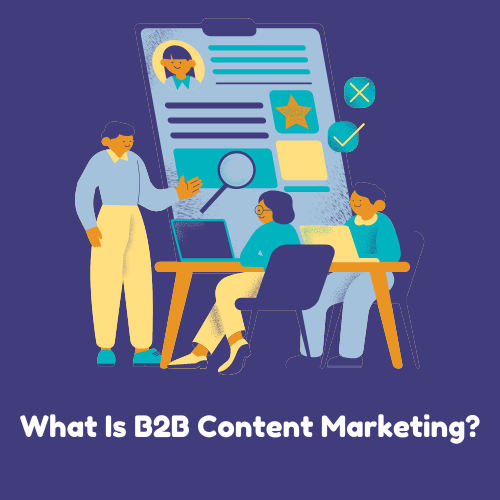
Generally speaking, content marketing refers to the tactics and strategies you use to create and distribute content to your target audience.
The difference with B2B content marketing is that you’re directly targeting the decision-makers in businesses within your niche, rather than B2C customers.
With B2B content marketing, you’re looking to:
- Establish your brand as a thought leader
- Increase brand awareness
- Generate more leads
- Nurture leads and move them further down the sales funnel
- Improve customer retention
- Encourage user engagement with your various marketing channels
How does this differ from business-to-customer (B2C) marketing?
Well, for a start, B2B content marketing is primarily aimed at the decision-makers within other businesses. On the other hand, B2C content is aimed at a broader audience of individual consumers. The consumers within these two groups have very different motivations.
Typically, B2C consumers are motivated by entertaining and emotive content. B2B consumers tend to be more motivated by content that demonstrates expertise and efficiency. They’re often looking for educational content that helps them make a purchasing decision for the entire business.
Naturally, this means there are big differences in the types of content and marketing strategies that work for each audience.
What Is The Buying Centre And Why Is It Important?

Before I discuss creating a successful B2B content strategy, you need to know about the buying centre.
The buying centre is the group of individuals within a business that you’ll target with your content marketing efforts. Ultimately, these are the people who will decide whether a business purchases your product or not.
Depending on the type of product/service you sell, the group of employees you target with your content marketing strategy can vary. However, the buying centre is typically divided into five roles. Let’s break them down.
1. The user
This employee will use your software on a day-to-day basis. They don’t make any purchasing decisions but other employees in the buying centre ask them for feedback on your product since they’ll be using it the most. If they provide a positive report, there’s a good chance of you earning a sale.
2. The data collector
The data collector role can be carried out by a variety of different employees. Within some businesses, it might be a marketing assistant. In others, it could be a managing director. So, it’s essential that you find out who is fulfilling the role in the buying centre you target.
The data collector usually doesn’t make purchasing decisions. Yet, they’re in charge of researching your product and brand and providing data to the decision-makers.
3. The consultant
The consultant has a lot of expertise and experience within your niche, and they’ve used software similar to yours for many different purposes. They’re often external to the business and are brought in to analyse your software and give an unbiased opinion to the decision-makers.
Due to their external nature, consultants are harder to target with digital marketing than other roles in the buying centre.
4. The buyer
The buyer doesn’t actually make the purchasing decision but they’re in charge of working out all the details of the purchase. For instance, they’ll discuss pricing and discounts with you, and agree on the terms of the contract.
They stay in close contact with the decision-makers and provide information on the value and cost-effectiveness of your product.
5. The decision-maker
The decision-maker is influenced by the data and information provided by the other roles in the buying centre. They use all of this information to make the final purchasing decision.
You should target decision-makers with your content strategy. However, you also need to target the other roles in the chain to ensure they have a positive influence on the employee who makes the purchasing decision.
What Is The Buyer’s Journey And Why Is It Important?

Another key concept you need to understand before you formulate a B2B content marketing strategy is the buyer’s journey. This refers to the different stages a buyer goes through before purchasing your product.
Generally, the buyer’s journey is divided into three stages:
- Awareness: The buyer becomes aware of a problem/issue their business has. This is also commonly known as the top-of-the-funnel (ToFu) stage.
- Consideration: The buyer conducts in-depth research into the issue and starts to compare various solutions to it. This stage is also referred to as the middle-of-the-funnel (MoFu).
- Decision: The buyer chooses the best product/service to solve their issue. This is also known as the bottom-of-the-funnel (BoFu) stage .
By familiarising yourself with each stage, you can craft content that addresses the specific pain points, concerns, and objections buyers have at each stage of their journey.
This ensures your content is relevant and valuable to users. Plus, it helps you create content that nurtures leads and moves them to the next stage of the journey. Ultimately, this is what you’ll need to do to get prospects to convert.
5 Steps To Create A Successful B2B Content Marketing Strategy
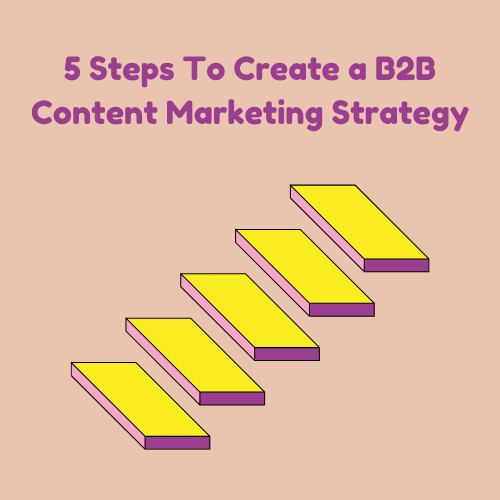
Now, you have an understanding of B2B content marketing, the buying centre, and the buyer’s journey. But how do you build on this knowledge and create an effective content marketing strategy?
Well, I’ve laid out five easy-to-follow steps that’ll get you on the road to success.
1. Research your audience
The first step involves gaining a deep understanding of your target audience. I’m not just talking about the buying centre here. I mean the broader audience that you want to reach with your content.
To come up with effective content ideas, you need to understand your audience’s interests, pain points, the channels they interact with the most, and much more.
Here are some steps you can take to ensure you truly understand your target audience:
- Talk to your sales team: Your sales team regularly interacts with your existing customers and prospects. So, ask them for input on the common pain points, objections, and queries they hear on sales calls.
- Analyse existing customers: Evaluate the data you have for your existing customers and pay attention to the company sizes, demographics, and industries. You can also survey your customers to learn about their preferences, challenges, and needs.
- Website and content analytics: Check the performance data for your site and published content to see which topics and formats perform best among your audience.
- Stay on top of industry trends: Ensure you’re always up-to-date with new industry developments. This allows you to pinpoint emerging opportunities and challenges your audience could be facing.
- Use keyword research tools: Use keyword research tools like Semrush to identify the terms your audience searches for online. This helps you understand the topics they’re interested in and the common queries they have.
- Make use of professional networks: Find the online communities and industry associations where your audience congregates. Join their discussions and make a note of their interests and concerns.
- Employ social listening: Identify topics and hashtags relevant to your niche. Then, monitor the conversations your target audience has about them on social media. This can give you insights into the specific concerns your audience has about a particular topic.
Creating content without understanding your audience is like going on a treasure hunt without a map. You need to conduct extensive research to craft targeted content marketing campaigns that generate leads and increase conversions.
2. Define your goals
The next step of your B2B content marketing strategy is to establish the outcomes you want to achieve. Of course, these may vary between businesses. Still, there are some common goals that most businesses hope to accomplish, such as:
- Establishing thought leadership: Creating high-quality content that clearly demonstrates your expertise and establishes your brand as a thought leader within your niche.
- Increasing brand awareness: Boosting the visibility of your brand and its recognition among your audience. The content you create should keep your brand top-of-mind for your prospects and customers.
- Generating leads: Encouraging readers to give you their contact info so that you can start nurturing them from leads into paying customers.
- Improving SEO: Creating content that ranks high in SERPs and boosts the organic traffic to your website.
- Educating users: Providing prospects with educational content that helps them overcome doubts and objections.
- Retaining customers: Improving customer retention rates by crafting content that nurtures your existing relationships.
Defining your goals is vital as it determines the approach you take with your content strategy. Depending on your desired outcomes, you can cover different topics, address specific pain points, and use varying content formats.
3. Research your competitors
It’s also important you research your competitors’ content marketing strategies. You should aim to identify the areas in which they’re succeeding and where they’re not. Plus, you need to understand the keywords your competitors are targeting with their SEO content.
When I do this type of research, I usually rely on Semrush’s Organic Research and Keyword Gap tools.
4. Align your content with the buyer’s journey
Once you’ve researched your audience and competitors and established your goals, it’s time to create content that aligns with the buyer’s journey.
As I mentioned earlier, the three stages of the buyer’s journey are awareness, consideration, and decision. So, let’s take a look at how to align your content with each stage.
1. Awareness stage content
In the first stage of the journey, you should provide users with educational content that gives them more information about their pain points and how they can solve them.
Some of the best types of B2B content for the awareness stage include:
- Blog posts: Blog posts are perfectly suited to the awareness stage of the buyer’s journey. They should be highly relevant to search intent and provide value to the reader. This means including unique perspectives and fresh info that isn’t readily available.
- How-to videos: Concise, instructional videos are an excellent way to educate users about a problem and show them how they can resolve it. Your videos should be highly accessible and use visuals and language that are very easy to understand.
- Social media posts: Sharing posts on your social media channels is another effective way of marketing to users in the awareness stage. You should post short-form content relevant to your audience’s pain points and include links to your long-form content.
- Checklists: Often, when users need to complete complicated tasks, they’re looking for straightforward checklists that tell them what to do. Ensure your checklists include informative graphics and are laid out in a logical order.
- Whitepapers: A whitepaper is your brand’s definitive guide or report on a specific topic. Typically, they’re downloadable assets that go into great detail. Your whitepapers should include original research that users can’t find elsewhere. This increases their value and makes them a desirable option.
2. Consideration stage content
As users in the consideration stage are now aware of their issue, you need to provide them with content that convinces them you have the best solution.
Your content should be designed to nurture leads and move them to the final stage of the buyer’s journey. Here are some content types you can use to do that:
- Case studies: A case study is a good content type for both the consideration and awareness stages. It gives real-world examples of how your product/service has helped businesses solve pain points that are relevant to your audience. It often includes info about the client, a detailed explanation of the pain point/s, and an in-depth description of how you solved it.
- Product/service comparison guides: Users in the consideration stage are still deciding on the best solution to their problem. So, comparing your product/service to your competitors is a great idea. Focus on the benefits of your product/service and the reasons it’s better than what your competition offers, without being overtly biased.
3. Decision stage
The content you create for the decision stage gives you an opportunity to remove any remaining objections and create a frictionless customer experience.
Users are now considering the specific offerings and pricing from you and your competitors before making their final decision.
The best types of content for this stage include:
- Free consultation offers: Free consultation offers provide your prospects with something tangible in reward for having a conversation with a member of your sales team. The consultation should include free actionable advice that demonstrates your expertise and gives the user an idea of how you’ll help them solve their pain points.
- Free trials: Often, the best way to get users to convert is to create content promoting a free trial of your product/service. Once they’ve tested it out and realised it can solve their issues, they should be ready to make a purchase.
- Live demos: Similarly, live demos are ideal for demonstrating the features and benefits of your product/service. They’re a super direct way of showing users why they need what you’re offering.
5. Track your performance
The only way to measure the success of your B2B content marketing strategy is to track its performance over time. This means analysing specific performance metrics using tools like Semrush and Google Analytics.
The most important metrics you need to keep an eye on are:
- Engagement metrics: This includes bounce rate, time on page, and social media interactions. These metrics are good indicators of how relevant and engaging your audience finds your content.
- Conversion rates: This metric measures the number of visitors who take desired actions like making a purchase and subscribing to a newsletter. They tell you how successful your content is at turning leads into paying customers.
- Lead generation metrics: These metrics include Sales Qualified Leads (SQLs) and Marketing Qualified Leads (MQLs). They give you a good idea of how many leads your content is generating and the quality of these leads.
- Website traffic: You should also analyse your traffic sources, overall traffic, and page views. This tells you which are your most effective content marketing channels and helps you understand your content’s reach.
- SEO performance metrics: Monitor metrics like organic search traffic, keyword rankings, and domain authority to assess the visibility of your content online.
Book A B2B Content Marketing Strategy Call With My Content Pal Today!
Creating a highly successful B2B content marketing strategy isn’t easy and it can be very time-consuming. So, why not let My Content Pal do all the hard work for you? Schedule a content strategy call with me today and I’ll show you how we can help your business reach its objectives.
FAQs
Can you repurpose B2B content from other marketing channels?
Absolutely! In fact, repurposing content from other channels is a great way to reach a wider audience and increase the value of your content. Here are some tips for repurposing content:
- Use information from your whitepapers and case studies to create infographics.
- Extract content from a blog post and turn it into an engaging social media post.
- Extract audio from your webinars and insert it into podcasts.
- Create roundup posts by compiling key insights from various pieces of content.
Should I hire a B2B content marketing agency?
You could handle your B2B content marketing yourself it’s incredibly time-consuming and hard to get results. Instead, you should consider hiring an agency like My Content Pal.
We can use our expertise and years of experience to craft a strategy that increases engagement, generates leads, and boosts conversions. All for a price that won’t break the bank.
What are some common mistakes businesses make with B2B content marketing?
Some of the most common mistakes I see B2B content marketers make include:
- Creating content that’s too “salesy” and which doesn’t actually provide any value to the user.
- Diving in head first without creating a strategy.
- Failing to align content with the buyer’s journey.
- Allowing older content to become outdated and irrelevant.
- Creating good content but neglecting promotion and distribution.
Final Thoughts
Building an effective B2B content marketing strategy requires a fairly extensive amount of knowledge, research, and content creation. Remember, it’s vital that you have a deep understanding of the buyer’s journey and the buying centre before you implement your content strategy.
To see how successful strategies are put into action, take a look at these B2B content marketing examples for inspiration.
Then, you need to follow the steps I laid out in this article, such as researching your audience, defining your goals, creating content that aligns with the buyer’s journey, keeping up with trends, and educating yourself on the future of content marketing. If you follow my roadmap, you’ll have a strategy that establishes your brand as a thought leader, increases brand awareness, generates more leads, and much more.
Contact My Content Pal to learn about our SEO solutions that drive conversions.
